CENTRAL INDIA: Caves, ruins, and a very big tree

From Aurangabad and the cave temples of Ellora we start to arc north on our big loop through central India. The next destination is another great cave temple site, Ajanta, older and if possible even more impressive than Ellora. After that we continue on to an extremely old Buddhist pilgrimage site, Sanchi, via the infamous industrial city of Bhopal, and then, somehow or other, back to Delhi. This is the “hard travel” part of our trip. We have to find local buses, trains, or other transport as we go. There are no schedules, and no reservations.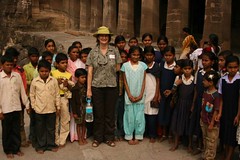
The first leg, from Aurangabad to Ajanta, is an easy one. Although there is no English – numerically or alphabetically – at the bus stand, lots of people direct us to our bus, which is just pulling out, and magically still has seats. It drops us directly in front of the only reasonable accommodation in the village of Fardarpur, and just like that we have arrived and are settled in.
We are definitely objects of curiosity when we take a stroll through tiny Fardarpur, but the attention is unanimously friendly, and even heart-warming, as when a bullock cart of villagers lumbers past and everybody in the back – mostly women and girls – waves and flashes brilliant smiles, and keeps waving as they trundle up the road. It has been eight years since we were last here, 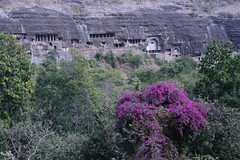 and I remember buying a cold beer at a small shop just north of the town, but now I can’t find the place. We ask a small knot of young men, and they say it is 2 km further. There is an auto-rickshaw beside them, and I say I’ll take that, but everybody, including the driver, agrees that he will charge too much. One guy flags down a 100cc motorbike, tells him what we want, and Katheryn and I squeeze on board. Our driver’s name is Ali. He is about to move to Ireland to be with a girl he met, and has no idea what to expect. We complete our errand, and Ali refuses any payment, even a contribution to his gas money.
and I remember buying a cold beer at a small shop just north of the town, but now I can’t find the place. We ask a small knot of young men, and they say it is 2 km further. There is an auto-rickshaw beside them, and I say I’ll take that, but everybody, including the driver, agrees that he will charge too much. One guy flags down a 100cc motorbike, tells him what we want, and Katheryn and I squeeze on board. Our driver’s name is Ali. He is about to move to Ireland to be with a girl he met, and has no idea what to expect. We complete our errand, and Ali refuses any payment, even a contribution to his gas money.
Ajanta is a jewel. The 30 caves were carved by Buddhist monks, the interiors covered with stupendous frescoes, and the whole thing was abandoned by the end of the 5th C. The stunning paintings weren’t seen again until 1819, when a British army officer stumbled on the site,  following the Waghora River hunting tigers. There is still only the same approach, up the Waghora valley, into the box canyon where the caves form a horseshoe in the cliff face. Those of you who know Ajanta know what an amazing place it is. I won’t go into the details here, but let the pictures speak for themselves. More can be seen below, or on our flickr site, of course.
following the Waghora River hunting tigers. There is still only the same approach, up the Waghora valley, into the box canyon where the caves form a horseshoe in the cliff face. Those of you who know Ajanta know what an amazing place it is. I won’t go into the details here, but let the pictures speak for themselves. More can be seen below, or on our flickr site, of course.
The next leg of our journey, from Fardarpur to Jalgaon, although short, could be a problem because we have to flag down and board a bus in mid-route, and you can see, if you watch some of our bus videos like this one: bus through Madhya Pradesh how full the buses can be. As it turns out, the bus nearly empties out when it stops, and we actually have a selection of seats to choose from. Jalgaon itself is just a transit town on the rail line, but it has a nice hotel, the Plaza, whose charming owner greets us warmly. There is a waiting list of 29 for the train we want to catch to Bhopal the next morning. It is an early train – 6:30 a.m. – and by the time we get to the pre-dawn platform, our seats are confirmed. This is all just too easy! Where is all the hard travel I was dreading?
Bhopal will always be associated with the worst industrial accident of all time, when a gas leak from the Union Carbide plant seeped out into the city, killing 20,000, and destroying the health of 120,000 more. Admittedly, that isn’t likely to be a big draw for visiting the city, and since we didn’t find anything else that is, I would say give the place a miss. We arrive on the eve of the loudest Hindu festival of the year, Shivaratri, and are in a room directly across from a temple. The blaring broadcast, the manager says with conviction, will stop at 11 p.m. What he didn’t tell us was that the marble tile cutting in the next room wasn’t going to stop until the 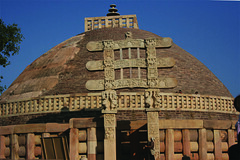 room was finished. The din in the room is unbelievable, and, tolerant as we are, we have to move when the shriek of saw cutting stone drowning out the blasting loudspeaker becomes too much.
room was finished. The din in the room is unbelievable, and, tolerant as we are, we have to move when the shriek of saw cutting stone drowning out the blasting loudspeaker becomes too much.
Sanchi is only a speck on the map 69 km from Bhopal, but still we weren’t expecting the bus to take 3 hr. to get there. It just crawls along through the Madhya Pradesh countryside, stopping every few hundred m to let off or pick up (mostly) passengers. People seldom get on singly, but in extended family units. The strongest – the young men – make it on first, and with the aisles already full, it often leaves old women or children to be crammed together in the doorway. The situation looks grim until the next stop, when another 8 or 12 or 20 people somehow manage to squeeze in, and then it gets worse.
Sanchi is the oldest site on our route – it has been a pilgrimage destination since the 3rd C B.C.,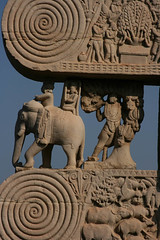 when the Emperor Asoka built a domed stupa over a relic of the Buddha. The stupa still stands, and Buddhist pilgrims still come – a group from Cambodia are here with us – but what Sanchi is famous for are its four gates. Called “Torana” they consist of two stone pillars supporting three horizontal beams, and they are the best, earliest, carving in India. The sculpture really is spectacular, but we had hoped Sanchi would be the kind of peaceful hamlet it would be nice to spend a few quiet days (after Bhopal) in. Unfortunately it’s just a rather unattractive strip on a busy road, and we decide to move on, the next day, to a beautiful spot we know, Orchha.
when the Emperor Asoka built a domed stupa over a relic of the Buddha. The stupa still stands, and Buddhist pilgrims still come – a group from Cambodia are here with us – but what Sanchi is famous for are its four gates. Called “Torana” they consist of two stone pillars supporting three horizontal beams, and they are the best, earliest, carving in India. The sculpture really is spectacular, but we had hoped Sanchi would be the kind of peaceful hamlet it would be nice to spend a few quiet days (after Bhopal) in. Unfortunately it’s just a rather unattractive strip on a busy road, and we decide to move on, the next day, to a beautiful spot we know, Orchha.
This involves picking up the (packed) bus from yesterday, which continues onto the town of Vidisha. From where we have to hope for seats on the six hour train to Jhansi. The good news is we get into one of the upper class compartments; the bad news is that we were sold the wrong kind of ticket at the station, and have to pay a “fine” of 500 rupees. In Jhansi station, before we head out to the village of Orchha, we try to buy tickets for our last leg, to Delhi. It’s such a chaotic scene 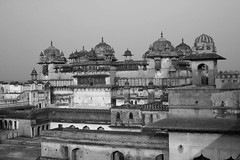 that I am in line for an hour and a half before I get to the window and then I can only get us on a waiting list.
that I am in line for an hour and a half before I get to the window and then I can only get us on a waiting list.
It’s a hassle getting out to Orchha, with taxi drivers telling us “there are no buses”, but it is worth the effort. The village of Orchha is sandwiched between a massive palace and a huge temple from the 17th C., and the countryside is dotted with ruins. We spend a day cycling around and are attracted to a giant 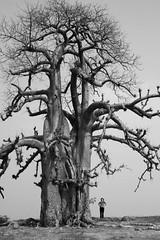 baobab tree standing alone on a hill. It is a tree that seems to be older than its country, to have created the magical landscape around it.
baobab tree standing alone on a hill. It is a tree that seems to be older than its country, to have created the magical landscape around it.
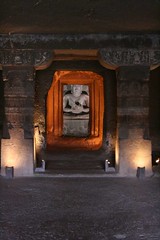
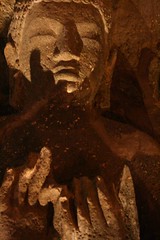
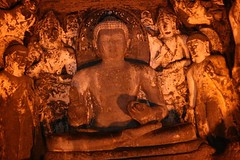
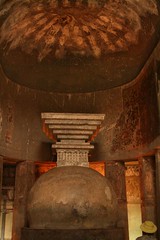
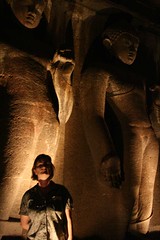
See lots more fabulous photos at http://www.kebeandfast.com and don’t miss the videos:orccha palace , sanchi ,and ajanta.
